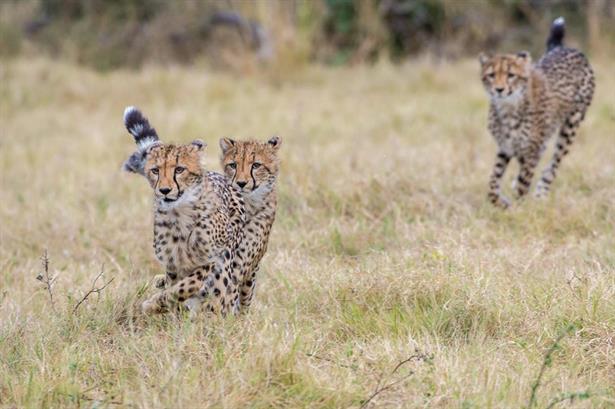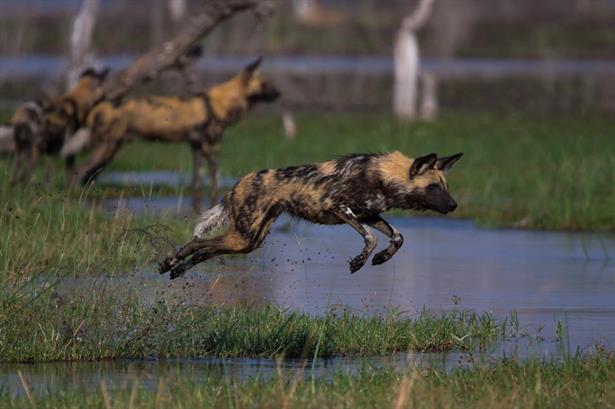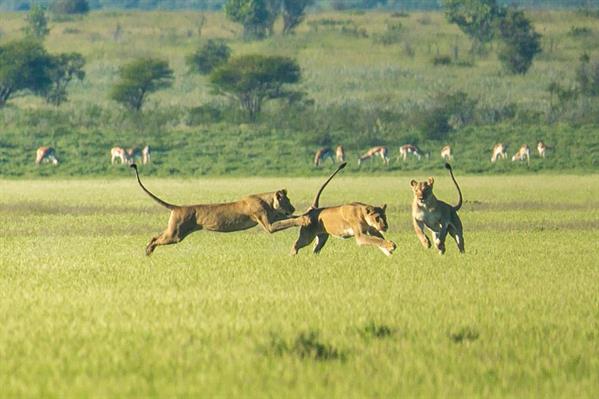Kwando Camps in Botswana
Kwara Concession
It’s hard not to get tied up in the events that surround the animals that we see every day. It’s human nature to ‘reflect’ our emotions and interpretations of behaviour onto the animals. Some days, it just feels like you are in the middle of a soap opera. Take the afternoon where the mother cheetah was found with only one of her three cubs. She spent the late afternoon calling and calling, for her other cubs to join… but there was no response. Even as darkness fell, as the cars moved off, she could still be heard calling. So, talk that night at the dinner table was concern – guides, guests, managers, all wondering what had happened to her other cubs? Would they find each other? Had they been attacked and killed by another predator? Will the single cub disappear as well, or stay on with the mother.

The next day, everyone was looking for the cheetah, to continue the story. And although it doesn’t happen often in the bush, there was a happy ending. When mother cheetah was found, all three cubs were with her, looking no worse for wear! Relief all round for the guests and staff alike… until the next episode of “Days of our Lives”.
In actual fact, the cheetah mother appears to be doing well at teaching her offspring good hunting techniques, and the four of them are regularly pulling down impala and other game. It’s possible that during an attempted hunt in the middle of the day, they got separated.
Other than that stressful time, we had other days of good sightings of the cheetah family, including where we watched them all attempt (unsuccessfully) to hunt. The same day, we came upon a male cheetah, and he stalked and killed a baby reedbuck right in front of us.
The pride of seven lions with three young was seen several times at the beginning of the month, looking for something to hunt. They had no luck whilst we were watching… a little later, a male and female lioness took a chance to try and hunt some warthogs, which they did manage to catch.
Male lions – the epitome of strength, bravery, fierceness. We came across four big males – the Marsh boys, calling and sounding off, roaring for dominance of their territory. Talking to other cars out, some distance away, they had located the four new males known as the Zulu boys, also roaring and sounding off, vying for dominance of this area. The two ‘teams’ slowly moved towards each other, calls getting louder and stronger. Everyone pictured the battle that was about to ensue – 8 fully grown male lions, evenly matched… what a scene! Until they reached about 1km away from each other, and both “sides” carefully turned round and walked in the opposite direction….
On the 20th August we came across the four Zulu boys, who had killed a 6-7 year old elephant. They had scars that were not there the day prior, and one of the four was limping badly, so we suspect they had finally had the fight with the Marsh boys that they put off earlier in the month… They rested up next to the elephant carcass for four days, before moving off – but not before striking dead a hyena who got too close to their meal…
A leopard was found dining on a baboon – but was very shy, so we moved off so that he could settle down properly. A few days later, we saw what was possibly the same shy male, mating with a female.
An interesting sighting of five wild dogs that were seen feeding on an impala. What was interesting about them was that they were not from a pack that we recognised! Perhaps we have a new group trying to edge their way into the old territory of the big pack…. Thirteen of the big pack of dogs were seen in the several times, on one occasion, they hunted and caught a big warthog… finishing all the meat in a matter of minutes. The pack were seen regularly through the month, and we also saw one pack of six dogs having an aggressive interaction with the big pack, before they ran away and crossed the channel by the boat station.
A slightly smaller kill was made by a honey badger – some frantic digging paid off, with a yummy rat to eat.
Lagoon

The whole Lagoon pride – four adult females and four sub adults cubs were around and about at the start of the month. We also came across a solitary male. The following week, near John pan, we came across three lionesses, with two cubs about 2 months old. During the month, we saw both prides hunting and killing buffalos – the large herds that have built up over the last months are providing a good food resource for the cats.
Two very well fed male lions were located between Lagoon camp and the immigration post, resting next to the river. The animals were very lazy, dragging their full belly. A beautiful caracal was also located along the same road and a hyena was edging along the tree line.
A female leopard was found to the west of the airstrip, and then the next day resting up on a termite mound. A male leopard new to the area has been seen twice now, appearing quite relaxed. We are hoping this gentleman stays around! We have also had several sightings of the female leopard that we saw last month with two cubs. Unfortunately she appears to have lost one of the cubs, and has only been seen with the remaining female cub.
Fourteen member of the pack of 17 wild dogs paid us a visit on the morning of the 4th August, but then sped back to Lebala area for the afternoon! Also, a new grouping of dogs – 4 males and 1 female – that we don’t recognise were seen hunting. We came across them when we were watching a lovely relaxed group of sable – suddenly the five dogs came dashing out of the bush nearby, trying to drive the huge antelope away. The sable did not budge, and stood their ground, with the dogs eventually giving up and walking away.
A little later in the month, with the big pack having abandoned the den at Lebala, the pack of 17 and 8 puppies spent some time around Lagoon. Whilst up there, they also bumped into a pack of 13 that they found in the area, and there were some clashes!
An unusual sighting of a pelican this month! Also lots of sightings of a big herd (about 35) of sable, as well as a herds of around 25 roan.
Lebala

Lots of lions in the area, including a female with three small cubs, a pride of five lionesses, and three different males. Unfortunately one of the small cubs was lost mid way through the month, and lioness was seen with only two for the rest of the month.
For July, the wild dogs did well with their 8 puppies. Early on in August, they decided that their puppies were old enough to leave the den, and begin to move with the pack. Although the puppies are still little, and can’t run the distance and speed that the adults can, the pack will move them from spot to spot, with a caretaker, and do their hunts from there. Around the 14th of the month, they moved into an area where the large buffalo herds hang out, and lions are commonly seen. It’s unlikely that would choose to stay in that area for very long.
By the end of the month, the puppies were growing up nicely, and all eight of them were trying to keep up with the 17 adults as much as possible.
One of the leopardesses that we haven’t seen for a while has moved back into the area again. She looks in good condition, and she had caught a jackal when we found her.
In order to differentiate between animals, regularly seen individuals are often given names. So then it comes down to the challenge of what to name them? Typically, if there is a pack or a pride, you try and have names with the group that are associated (eg members of a well-known football team, chiefs or kings and queens, even varieties of wines!) For solitary individuals, such as territorial male lions, it’s less necessary to have a name that is associated with a group, and one can select a more individual name, perhaps from a characteristic or story about that individual. Guests at Lebala were slightly alarmed to hear one very large male lion being referred to as “Drop the Pilot”. Sounding rather like an incident of lion training gone horribly wrong, an inquiry was made… Was a pilot perhaps taken to the wrong end of the airstrip and left there to meet this lion? Apparently not. This lion has a very tall mane, one side of which stands straight up, then flops down over his eye. This particular hairstyle is currently very popular with the ladies of Botswana, and is called “Drop the Pilot” (for some completely unknown reason….). And this is how the lion acquired the name…
Drop the Pilot and his buddy, Sebastian (not sure about that one either…), were seen often through the month, but were not involved in a great buffalo hunt which occurred on the 26th. Four lionesses, with two 2 month old cubs safely stashed away, spent the day hovering around a herd of buffalo – over 1000 of them. By late afternoon, the herd was very antsy, and the lionesses tried to fragment them. Initially facing five big male buffalos, the males turned and ran. One lioness pulled away from the three, and began harassing a mother and calf. She grabbed the calf and pulled it down, with the mother buffalo continuing to try and attack her. Realising that she was in jeopardy from the attacking buffalo, the lioness grabbed the calf in her mouth, lifted all four of its feet in the air, and ran off.
Soon after that, the lionesses regrouped and spooked the herd enough that it again fragmented, this time pulling down a larger sub-adult buffalo that had no chance of defending itself from the combined attack. The next day, having feasted on the buffalo during the night, they were found together with their cubs, resting up from the busy night.
Tau Pan

Now the camp is open again after a few weeks closed for standard maintenance, its time for everyone – and every animal – to get used to the way of life here. The temperature – although absolute freezing at the beginning of the month – soared to 34 degrees by the middle of August. Spring, if it was there, lasted about two days. The winds have started to pick up too, throwing dust into the sky, and creating that hazy look that we have to contend with for several months until the rain arrives.
The lions, naturally, could not care less whether we come or go. As far as they are concerned, Tau Pan (and often the camp itself) is their home. To welcome everyone back, two females set up just to the north of the camp with five cubs, feeding on an oryx. Two males sauntered in and out, grabbing a bit to eat, and the moving off to the waterhole.
The following week, the pride had caught another oryx, and all were sleeping and relaxing near by. The five cubs were hiding in the grass. One of the male lions was also seen mating with one of the pride females…. Another generation of cubs on the way?
Also adjusting to movement of humans back in the area, a male cheetah caught a young kudu on the edges of Tau Pan camp. Since kudus are often in the camp because of the thicker vegetation that is by and large, less browsed, it seems the cheetah has adapted his hunting skills accordingly!
An interesting thing this month is that it seems that the acacias and other flowering trees may bloom early. The Kalahari received a much higher than normal rainfall in April (certainly more than Maun or the Delta received at the same time) so there is still some moisture deep in the ground in some areas. It should be an interesting few months!
One of the guides, who had just spent a few weeks in our sister camp, Nxai Pan, commented on how different the behaviour of black backed jackals was in that area… Here in Tau Pan, the jackal spend their days hunting for their own food, and if there is a predator that has made a kill, waiting for a chance to dive in and grab a mouthful. In Nxai Pan, the guide noticed that every time there was a cheetah, there was a jackal a short distance away. “Jackals follow the cheetah for the whole day, asking for food!”. Perhaps Tau Pan jackals have a stronger sense of independence.
Odd sighting – tracks of elephants along the western firebreak, heading north. Interestingly, not far outside the CKGR, a herd of elephants was seen crossing the main road at Rakops! We also saw tracks of wild dogs, heading to the Passarge water hole. And the elusive brown hyena returns to the camp for more regular sightings!
A honey badger was having a rough day, being followed by a couple of goshawks. Eventually with a mouse in sight for the honey badger’s meal, the goshawks moved in in an attempt to flush the mouse out of the way and into their grasp… Lucky for the honey badger, he was quick enough to catch it!

